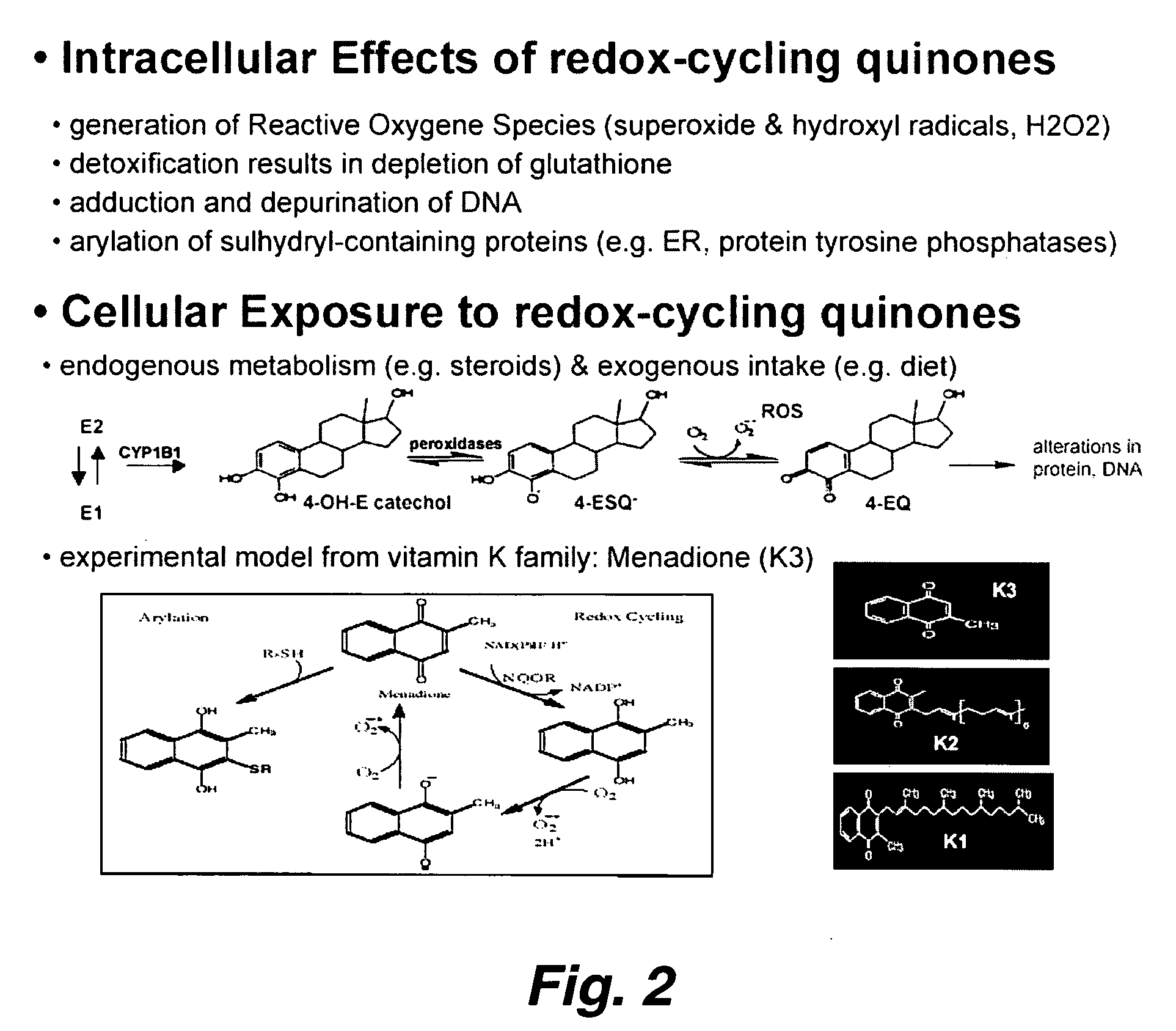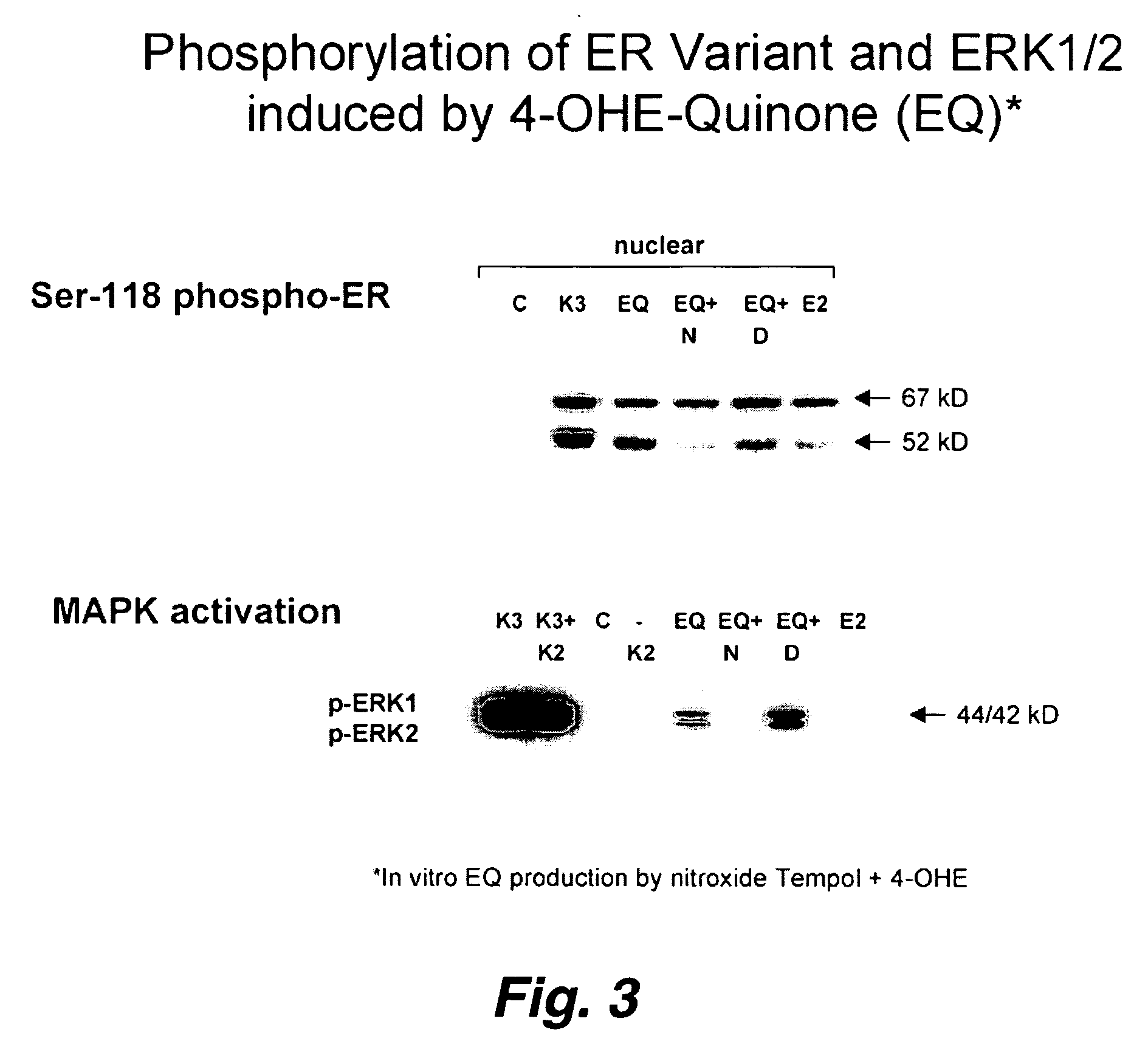Novel pathways in the etiology of cancer
a cancer and etiology technology, applied in the field of cancer and cancer therapeutics, can solve problems such as the complexity of understanding the er function
- Summary
- Abstract
- Description
- Claims
- Application Information
AI Technical Summary
Benefits of technology
Problems solved by technology
Method used
Image
Examples
example 1
Ligand-Independent, MAPK-Dependent Activation and Serine Phosphorylation of Wild-Type (67 kDa) and Delta7 (˜52 kDa) Isoform of Estrogen Receptor Alpha by the Redox Active Quinone, Vitamin K3 / Menadione
[0066] Ligand-independent activation of estrogen receptor alpha (ER) by membrane receptor-induced kinase signaling and phosphorylation of key serine residues(e.g., Ser-118) in the trans activating domain of ER is well described. Studying the varied effects of oxidants on ER structure and function, we treated ER-positive breast cancer MCF-7 and T47D cells growing in charcoal-stripped media with / without either thiol-reversible oxidants (e.g., H202, diamide) or the thiol-irreversible redox active and arylating quinone, vitamin K3 / menadione (1,2-naphthooquinone; 100 μM×30 min). Both types of oxidants induced a dose-dependent loss of ER DNA-binding. Menadione, but not the thiol-reversible oxidants, induced Ser-118 phosphorylation and nuclear translocation of 67 kDa (wild-type) ER. Additiona...
example 2
Increased NF-κB Activation Identifes an Oxidatively-Stressed and Clinically More Aggressive Subset of Estrogen Receptor (ER)-Positive Breast Cancers
[0067] Recent studies indicate that NFKB is required for mammary gland development and may be involved in the etiology of breast cancer. In particular, progression from hormone-sensitive estrogen receptor (ER)-positive to hormone-resistant ER-negative breast cancer has ‘been shown to be associated with marked upregulation and activation of NF-κB, as measured by nuclear translocation and / or DNA-binding by NFκB subunits (e.g., p50, p65), and consistent with the fact that ER and NF-κB appear to mutually inhibit the transcriptional activity of one another. Since hormone-resistant subsets of ER-positive breast cancer have long been clinically recognized but are difficult to predict at presentation, we have explored the hypothesis that such ER-positive subsets, potentially induced by increased exposure to oxidative stress, can be identified b...
example 3
Quinone-Induced and Ligand-Independent Phosphorylation of Estrogen Receptor Alpha (ERα) and a Breast Cancer Expressed Nuclear ERα Variant
[0070] In this example, we used ERα positive human breast cancer cell lines (MCF7, T47D) as model systems to study the response of endogenously expressed ERα protein to cell treatment with a redox-stressing quinone, the vitamin K analog menadione (K3). K3 is a widely used quinone capable of reversible redox-cycling (generating reactive oxygen species, ROS) and irreversible Michael addition-type arylation of various intracellular proteins with available cysteine (Cys) residues (25, 26), including ERα (27). We observed that K3 treatment of these cells in culture induces rapid ligand-independent activation and Ser-118 phosphorylation of endogenous 67 kD ERα. Analysis of this response further revealed that K3 induced Ser-118 and Ser-167 phosphorylation of a 52 kD ERα variant associating with the chromatin / nuclear matrix of these cells. This 52 kD ERα ...
PUM
| Property | Measurement | Unit |
|---|---|---|
| pH | aaaaa | aaaaa |
| pH | aaaaa | aaaaa |
| pH | aaaaa | aaaaa |
Abstract
Description
Claims
Application Information
 Login to View More
Login to View More - R&D
- Intellectual Property
- Life Sciences
- Materials
- Tech Scout
- Unparalleled Data Quality
- Higher Quality Content
- 60% Fewer Hallucinations
Browse by: Latest US Patents, China's latest patents, Technical Efficacy Thesaurus, Application Domain, Technology Topic, Popular Technical Reports.
© 2025 PatSnap. All rights reserved.Legal|Privacy policy|Modern Slavery Act Transparency Statement|Sitemap|About US| Contact US: help@patsnap.com



